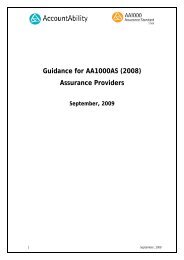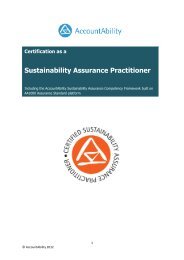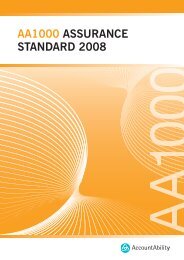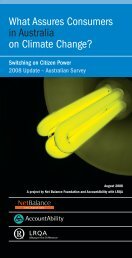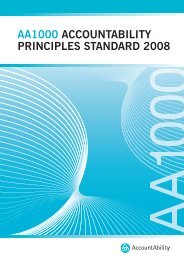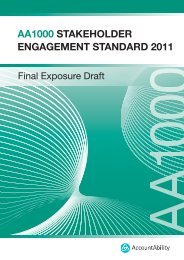The Stakeholder Engagement Manual Volume 2 - AccountAbility
The Stakeholder Engagement Manual Volume 2 - AccountAbility
The Stakeholder Engagement Manual Volume 2 - AccountAbility
Create successful ePaper yourself
Turn your PDF publications into a flip-book with our unique Google optimized e-Paper software.
Analyse and Plan<br />
P9: CHECKING FOR RESOURCE COMMITMENTS AND DEFINING “MARGINS OF MOVEMENT”<br />
SIG’s Consideration of its Positioning in relation to stakeholder expectations<br />
Following a range of surveys, consultations and workshops evaluating the concerns and expectations of stakeholders, the Swiss<br />
utilities company SIG undertook internal dialogues in order to defi ne it’s position on the identifi ed issues and expectations.<br />
Amongst various functions, the internal dialogue also involved the executive management team. <strong>The</strong> dialogue focused on identifying<br />
ways of ensuring that material stakeholder expectations are met. This involved a consideration of the company’s limitations, in order<br />
to ensure that SIG does not commit to actions that would exceed them. Simultaneously, potential strategic opportunities that were<br />
indicated by the stakeholder consultations were considered.<br />
Use stakeholder engagement when:<br />
BACKGROUND<br />
Factors to consider for the engagement itself:<br />
• Confl icting interests and dilemmas (internal and external), which might<br />
prevent or derail successful engagement.<br />
• Possibility of using/building on existing engagement processes and structures<br />
both internally and externally (e.g. customer panels, investor relations<br />
meetings, industry bodies, multi-stakeholder initiatives).<br />
• Th e geographical scale of the engagement. Is engagement on a local, regional<br />
or global (or all) scales required?<br />
For the response and outcomes:<br />
<strong>The</strong>re is a major issue confronting the company.<br />
<strong>The</strong>re is suffi cient overlap between the objectives and concerns<br />
of the company and those of the stakeholder.<br />
<strong>The</strong>re is concern about the impact of a company goal or strategy.<br />
It is necessary to improve the company’s knowledge of an issue.<br />
<strong>The</strong>re is an opportunity to help shape company goals and<br />
strategies.<br />
<strong>The</strong> company has suffi cient control or infl uence over a decision.<br />
<strong>The</strong> company needs to create more options for a planned action.<br />
All the decisions related to an issue have not yet been made.<br />
• Internal resources (systems, people, budgets, etc.) necessary to put insights<br />
and possible commitments into practice.<br />
• Confl icting interests and dilemmas (internal and external), which might<br />
prevent or derail possible actions (e.g. strict and low pricing targets for<br />
procurement vs. objectives for improved labour standards in the supply chain).<br />
• Margins of movement in relation to a specifi c issue. Th is means, what can and<br />
what cannot be done regarding an issue. Which stakeholder expectations can<br />
be met under which circumstances? Which cannot be met?<br />
<strong>The</strong>se are the guidelines that US consumer brand holding company Altria uses to help decide<br />
whether stakeholder engagement is appropriate.<br />
Don’t use stakeholder engagement when:<br />
<strong>The</strong>re is low or no company commitment to address an issue.<br />
<strong>The</strong> company has already made key decisions on the issue.<br />
<strong>The</strong>re is insuffi cient time to engage stakeholders.<br />
Addressing the issue is a relatively short-term business objective.<br />
<strong>The</strong> company’s primary concern is risk mitigation.<br />
<strong>The</strong> company is seeking buy-in through advocacy and persuasion.



